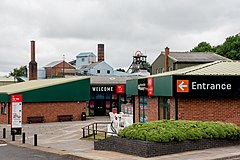|
National Coal Mining Museum for England
National Coal Mining Museum for England is based at the site of Caphouse Colliery in Overton, Wakefield, West Yorkshire, England. It opened in 1988 as the Yorkshire Mining Museum and was granted national status in 1995. HistoryCaphouse Colliery was sunk in the 1770s or 1780s and the Hope Pit in the 1820s. Sir John Lister Kaye of Denby Grange took over James Milnes' leases the mineral rights in 1827 and his pits became the Denby Grange Colliery. The boiler house and stone and brick chimney at the museum are Grade II listed structures[2] built around 1876 for Emma Lister Kaye along with the steam winding engine house, boiler yard, heapstead and ventilation shaft which are Grade II* listed.[3] The boiler house has two Lancashire boilers and powered the winding engine. The timber headgear at Caphouse and the wood framed screens building at Hope Pit date from between 1905 and 1911. Pithead baths and an administration block were built between 1937 and 1938.[4] Lockwood and Elliott who owned Shuttle Eye Colliery had acquired the colliery by 1942.[5] The colliery was nationalised in 1947 and a drift mine opened in 1974. The colliery closed in 1985.[4] Under the directorship of Margaret Faull, the Yorkshire Mining Museum opened in 1988. The museum became the National Coal Mining Museum in 1995.[4] In October 2022, the museum staff voted to strike over a below inflation pay offer.[6] Museum The museum offers guided underground tours where visitors can experience the conditions miners worked in and see the tools and machines they used as the industry and the mine developed through the years. Above ground, the museum sits on a 45-acre (18 ha) semi-rural site, with over a dozen galleries documenting the social and industrial history of the mines. The extensive library and archive contains a first edition of De re Metallica, as well as issues of "Coal News" and details of collieries throughout England. There are numerous other original features on site, including the pit head baths, steam winding house, boiler house and coal screening plant. The site maintains an operating paddy train connecting the main Caphouse hub to the Hope Pit area of the site, where a natural Water Treatment facility with reed beds and bird hides is operated in partnership with the Coal Authority. There is also an interpretive nature trail connecting the wooded valley area of the site. The museum has had many developments in recent years.[7] The Miners Memorial Garden was opened in 2015, and a large mining-themed adventure playground was built in 2017. Significant improvements to the visitor welcome hub, which contains the museum's retail, education, catering and conferencing facilities were made from 2018 onwards owing to funding from the National Lottery Heritage Fund. Since the early 1990s, the museum has hosted pit ponies and other horses with links to the Coal Mining industry. A new interactive Pony Discovery Centre was opened in 2021 replacing the older stables block sited in the Boiler Yard. The museum is an Anchor Point of ERIH, the European Route of Industrial Heritage.[8] The museum held the exhibition 'My Mining Days' for mining artist Tom Lamb in 2008–2009.[9] CollectionRailway LocomotivesBattery Electric Locomotives
Diesel Hydraulic Locomotives
Diesel Mechanical Locomotives
Steam locomotives
LocationThe museum is situated on the A642, in Overton near Middlestown between Wakefield and Huddersfield. It is signposted from the M1 motorway. It can be reached by car or public transport.[11] The museum features regularly on television programmes, especially those with a focus on genealogy and mining culture.[citation needed] See also
ReferencesFootnotes
Bibliography
External linksWikimedia Commons has media related to National Coal Mining Museum for England. |
||||||||||||||||||||||

